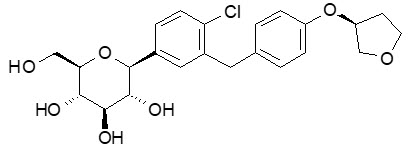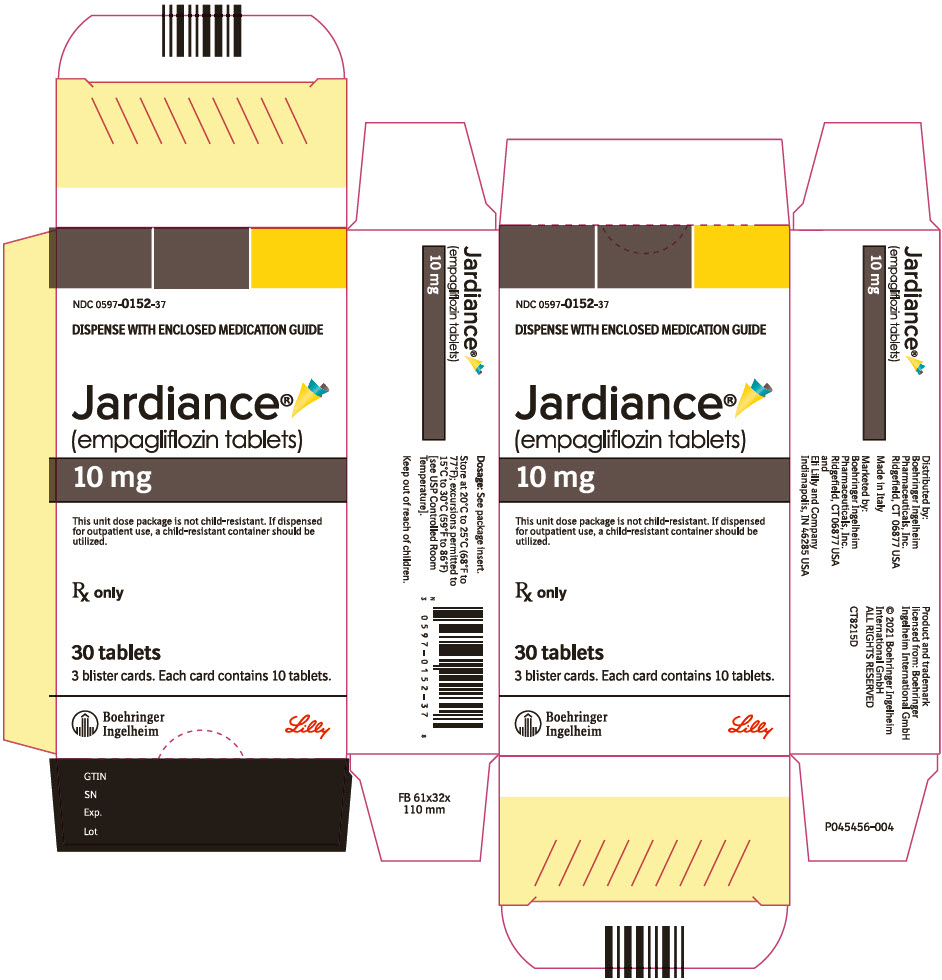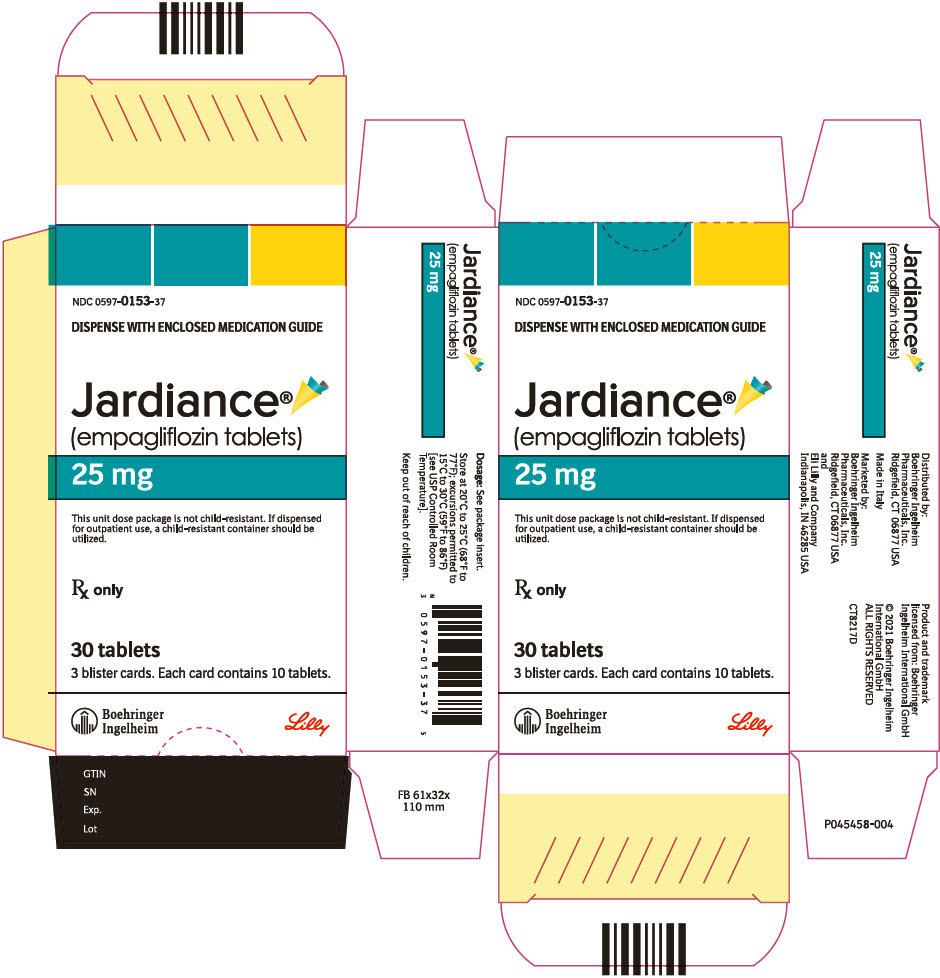Jardiance
Generic name: empagliflozin
Drug class: SGLT-2 inhibitors
Medically reviewed by A Ras MD.
What is Jardiance?
Jardiance is a prescription medicine used lower blood sugar along with diet and exercise in adults with type 2 diabetes, reduce the risk of cardiovascular death in adults with type 2 diabetes and who also have known cardiovascular disease, and reduce the risk of cardiovascular death and hospitalization for heart failure (when the heart is weak and cannot pump enough blood to the rest of your body) in adults with heart failure.
Jardiance is not for people with type 1 diabetes. It may increase their risk of diabetic ketoacidosis (increased ketones in blood or urine).
Jardiance is not for use to lower blood sugar in adults with type 2 diabetes who have severe kidney problems, because it may not work.
It is not known if Jardiance is safe and effective in children.
Description
JARDIANCE tablets for oral use contain empagliflozin, an inhibitor of the sodium-glucose co-transporter 2 (SGLT2).
The chemical name of empagliflozin is D-Glucitol,1,5-anhydro-1-C-[4-chloro-3-[[4-[[(3S)-tetrahydro-3-furanyl]oxy]phenyl]methyl]phenyl]-, (1S).
Its molecular formula is C23H27ClO7 and the molecular weight is 450.91. The structural formula is:

Empagliflozin is a white to yellowish, non-hygroscopic powder. It is very slightly soluble in water, sparingly soluble in methanol, slightly soluble in ethanol and acetonitrile, soluble in 50% acetonitrile/water, and practically insoluble in toluene.
Each film-coated tablet of JARDIANCE contains 10 mg or 25 mg of empagliflozin (free base) and the following inactive ingredients: lactose monohydrate, microcrystalline cellulose, hydroxypropyl cellulose, croscarmellose sodium, colloidal silicon dioxide and magnesium stearate. In addition, the film coating contains the following inactive ingredients: hypromellose, titanium dioxide, talc, polyethylene glycol, and yellow ferric oxide.
Mechanism of Action
Empagliflozin is an inhibitor of the sodium-glucose co-transporter 2 (SGLT2), the predominant transporter responsible for reabsorption of glucose from the glomerular filtrate back into the circulation. By inhibiting SGLT2, empagliflozin reduces renal reabsorption of filtered glucose and lowers the renal threshold for glucose, and thereby increases urinary glucose excretion.
Empagliflozin also reduces sodium reabsorption and increases the delivery of sodium to the distal tubule. This may influence several physiological functions such as lowering both pre-and afterload of the heart and downregulating sympathetic activity.
What is the most important information I should know about Jardiance?
Jardiance can cause serious side effects, including:
- Ketoacidosis (increased ketones in your blood or urine). Ketoacidosis has happened in people who have type 1 diabetes or type 2 diabetes, during treatment with Jardiance. Ketoacidosis has also happened in people with diabetes who were sick or who had surgery during treatment with Jardiance. Ketoacidosis is a serious condition, which needs to be treated in a hospital. Ketoacidosis may lead to death. Ketoacidosis can happen with Jardiance even if your blood sugar is less than 250 mg/dL. Stop taking Jardiance and call your healthcare provider right away or go to the nearest hospital emergency room if you get any of the following symptoms:
- nausea
- vomiting
- stomach-area (abdominal) pain
- tiredness
- trouble breathingIf you get any of these symptoms during treatment with Jardiance, if possible, check for ketones in your urine, even if your blood sugar is less than 250 mg/dL.
- Dehydration. Jardiance can cause some people to become dehydrated (the loss of body water and salt). Dehydration may cause you to feel dizzy, faint, light-headed, or weak, especially when you stand up (orthostatic hypotension). There have been reports of sudden worsening of kidney function in people who are taking Jardiance.You may be at higher risk of dehydration if you:
- take medicines to lower your blood pressure, including diuretics (water pills)
- are on low sodium (salt) diet
- have kidney problems
- are 65 years of age or older
Talk to your healthcare provider about what you can do to prevent dehydration including how much fluid you should drink on a daily basis.
Talk to your healthcare provider right away if you reduce the amount of food or liquid you drink, for example if you are sick or cannot eat, or start to lose liquids from your body, for example from vomiting, diarrhea or being in the sun too long.
Who should not take Jardiance?
- are allergic to empagliflozin or any of the ingredients in Jardiance. See the end of this Medication Guide for a complete list of ingredients in Jardiance. Symptoms of a serious allergic reaction to Jardiance may include:
- swelling of your face, lips, throat and other areas of your skin
- difficulty with swallowing or breathing
- raised, red areas on your skin (hives)
If you have any of these symptoms, stop taking Jardiance and call your healthcare provider right away or go to the nearest hospital emergency room.
- are on dialysis.
What should I tell my healthcare provider before taking Jardiance?
Before taking Jardiance, tell your healthcare provider about all of your medical conditions, including if you:
- have kidney problems.
- have liver problems.
- have a history of infection of the vagina or penis.
- have a history of urinary tract infections or problems with urination.
- are going to have surgery. Your healthcare provider may stop your Jardiance before you have surgery. Talk to your healthcare provider if you are having surgery about when to stop taking Jardiance and when to start it again.
- are eating less, or there is a change in your diet.
- have or have had problems with your pancreas, including pancreatitis or surgery on your pancreas.
- drink alcohol very often or drink a lot of alcohol in the short term (“binge” drinking).
- have type 1 diabetes. Jardiance should not be used to treat people with type 1 diabetes.
- are pregnant or plan to become pregnant. Jardiance may harm your unborn baby. If you become pregnant while taking Jardiance, tell your healthcare provider as soon as possible. Talk with your healthcare provider about the best way to control your blood sugar while you are pregnant.
- are breastfeeding or plan to breastfeed. Jardiance may pass into your breast milk and may harm your baby. Talk with your healthcare provider about the best way to feed your baby if you are taking Jardiance. Do not breastfeed while taking Jardiance.
Tell your healthcare provider about all the medicines you take, including prescription and over-the-counter medicines, vitamins, and herbal supplements.
Jardiance may affect the way other medicines work, and other medicines may affect how Jardiance works.
Especially tell your healthcare provider if you take:
- diuretics (water pills)
- insulin or other medicines that can lower your blood sugar
Know the medicines you take. Keep a list of them to show your healthcare provider and pharmacist when you get a new medicine.
How should I take Jardiance?
- Take Jardiance exactly as your healthcare provider tells you to take it.
- Take Jardiance by mouth 1 time in the morning each day, with or without food.
- Your healthcare provider may change your dose if needed.
- If you miss a dose, take it as soon as you remember. If you do not remember until it is time for your next dose, skip the missed dose and go back to your regular schedule. Do not take two doses of Jardiance at the same time. Talk with your healthcare provider if you have questions about a missed dose.
- Your healthcare provider may tell you to take Jardiance along with other diabetes medicines. Low blood sugar can happen more often when Jardiance is taken with certain other diabetes medicines. See “What are the possible side effects of Jardiance?”
- If you take too much Jardiance, call your healthcare provider or go to the nearest hospital emergency room right away.
- When taking Jardiance, you may have sugar in your urine, which will show up on a urine test.
- Your healthcare provider may do blood tests to check how well your kidneys are working before and during your treatment with Jardiance.
What are the possible side effects of Jardiance?
Jardiance may cause serious side effects, including:
- See “What is the most important information I should know about Jardiance?”.
- Serious urinary tract infections. Serious urinary tract infections that may lead to hospitalization have happened in people who are taking Jardiance. Tell your healthcare provider if you have any signs or symptoms of a urinary tract infection such as a burning feeling when passing urine, a need to urinate often, the need to urinate right away, pain in the lower part of your stomach (pelvis), or blood in the urine. Sometimes people also may have a fever, back pain, nausea or vomiting.
- Low blood sugar (hypoglycemia). If you take Jardiance with another medicine that can cause low blood sugar, such as a sulfonylurea or insulin, your risk of getting low blood sugar is higher. The dose of your sulfonylurea medicine or insulin may need to be lowered while you take Jardiance. Signs and symptoms of low blood sugar may include:
- headache
- drowsiness
- weakness
- irritability
- hunger
- fast heartbeat
- confusion
- shaking or feeling jittery
- dizziness
- sweating
- A rare but serious bacterial infection that causes damage to the tissue under the skin (necrotizing fasciitis) in the area between and around the anus and genitals (perineum). Necrotizing fasciitis of the perineum has happened in women and men who take Jardiance. Necrotizing fasciitis of the perineum may lead to hospitalization, may require multiple surgeries, and may lead to death. Seek medical attention immediately if you have a fever or you are feeling very weak, tired or uncomfortable (malaise), and you develop any of the following symptoms in the area between and around your anus and genitals:
- pain or tenderness
- swelling
- redness of skin (erythema)
- Vaginal yeast infection. Symptoms of a vaginal yeast infection include:
- vaginal odor
- white or yellowish vaginal discharge (discharge may be lumpy or look like cottage cheese)
- vaginal itching
- Yeast infection of the penis (balanitis). Swelling of an uncircumcised penis may develop that makes it difficult to pull back the skin around the tip of the penis. Other symptoms of yeast infection of the penis include:
- redness, itching, or swelling of the penis
- rash of the penis
- foul smelling discharge from the penis
- pain in the skin around the penis
Talk to your healthcare provider about what to do if you get symptoms of a yeast infection of the vagina or penis. Your healthcare provider may suggest you use an over-the-counter antifungal medicine. Talk to your healthcare provider right away if you use an over-the-counter antifungal medication and your symptoms do not go away.
- Allergic (hypersensitivity) reactions. Serious allergic reactions have happened in people who are taking Jardiance. Symptoms may include:
- swelling of your face, lips, throat and other areas of your skin
- difficulty with swallowing or breathing.
- raised, red areas on your skin (hives)
If you have any of these symptoms, stop taking Jardiance and call your healthcare provider right away or go to the nearest hospital emergency room.
The most common side effects of Jardiance include:
- urinary tract infections
- yeast infections in females
These are not all the possible side effects of Jardiance. For more information, ask your healthcare provider or pharmacist.
Call your doctor for medical advice about side effects. You may report side effects to FDA at 1-800-FDA-1088.
General information about the safe and effective use of Jardiance.
Medicines are sometimes prescribed for purposes other than those listed in a Medication Guide. Do not use Jardiance for a condition for which it is not prescribed. Do not give Jardiance to other people, even if they have the same symptoms you have. It may harm them.
You can ask your pharmacist or healthcare provider for information about Jardiance that is written for health professionals.
How should I store Jardiance?
- Store Jardiance at room temperature between 68°F to 77°F (20°C to 25°C).
- Keep Jardiance and all medicines out of the reach of children.
What are the ingredients in Jardiance?
Active Ingredient: empagliflozin
Inactive Ingredients: lactose monohydrate, microcrystalline cellulose, hydroxypropyl cellulose, croscarmellose sodium, colloidal silicon dioxide and magnesium stearate.
In addition, the film coating contains the following inactive ingredients: hypromellose, titanium dioxide, talc, polyethylene glycol, and yellow ferric oxide.
Label
PRINCIPAL DISPLAY PANEL – 10 MG TABLET BLISTER PACK CARTON
- NDC 0597-0152-37
- DISPENSE WITH ENCLOSED MEDICATION GUIDE
- Jardiance®
(empagliflozin tablets) - 10 mg
- This unit dose package is not child-resistant. If dispensed
for outpatient use, a child-resistant container should be
utilized. - Rx only
- 30 tablets
- 3 blister cards. Each card contains 10 tablets.
- Boehringer
Ingelheim - Lilly

PRINCIPAL DISPLAY PANEL – 25 MG TABLET BLISTER PACK CARTON
- NDC 0597-0153-37
- DISPENSE WITH ENCLOSED MEDICATION GUIDE
- Jardiance®
(empagliflozin tablets) - 25 mg
- This unit dose package is not child-resistant. If dispensed
for outpatient use, a child-resistant container should be
utilized. - Rx only
- 30 tablets
- 3 blister cards. Each card contains 10 tablets.
- Boehringer
Ingelheim - Lilly

SRC: NLM .